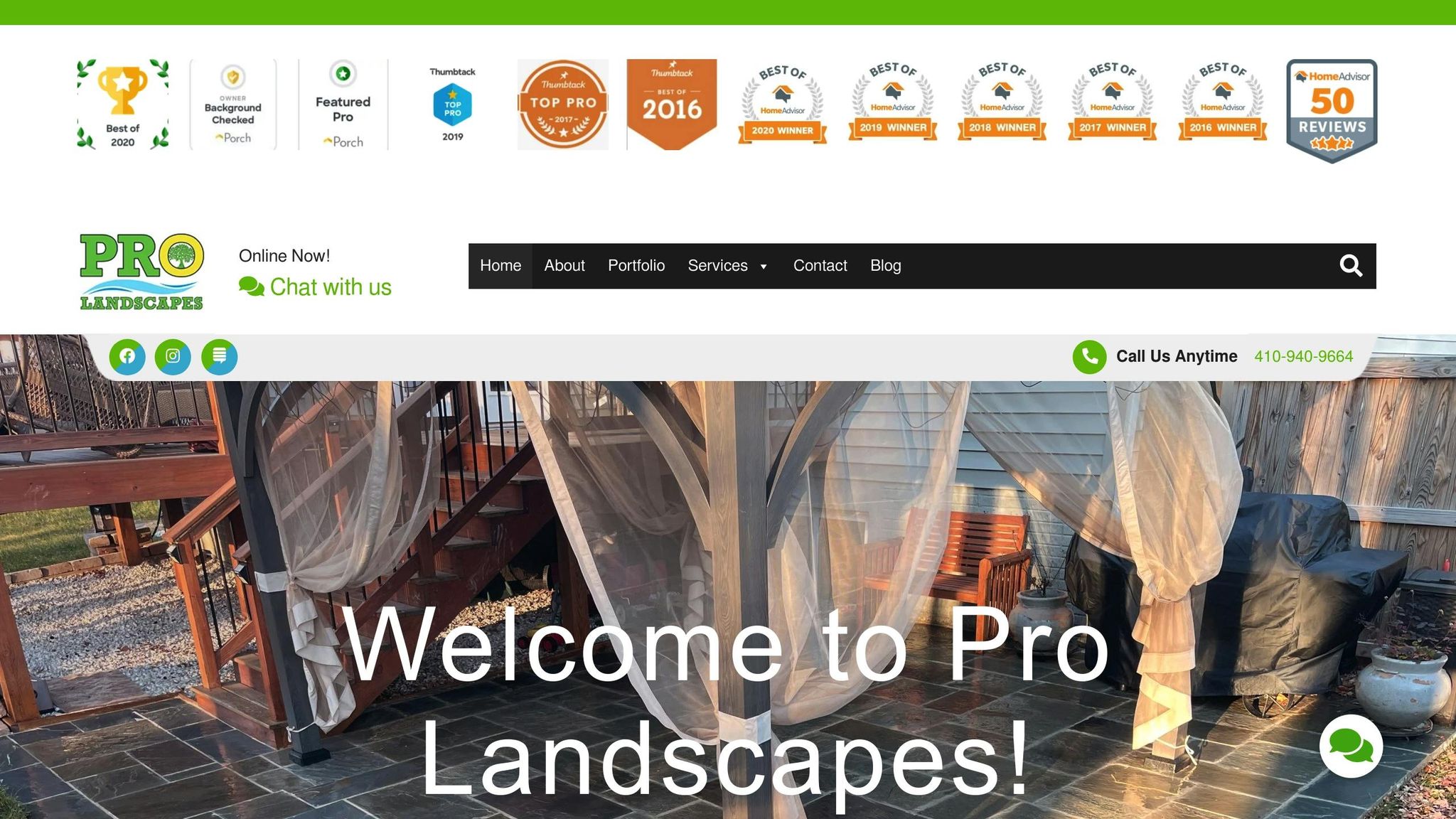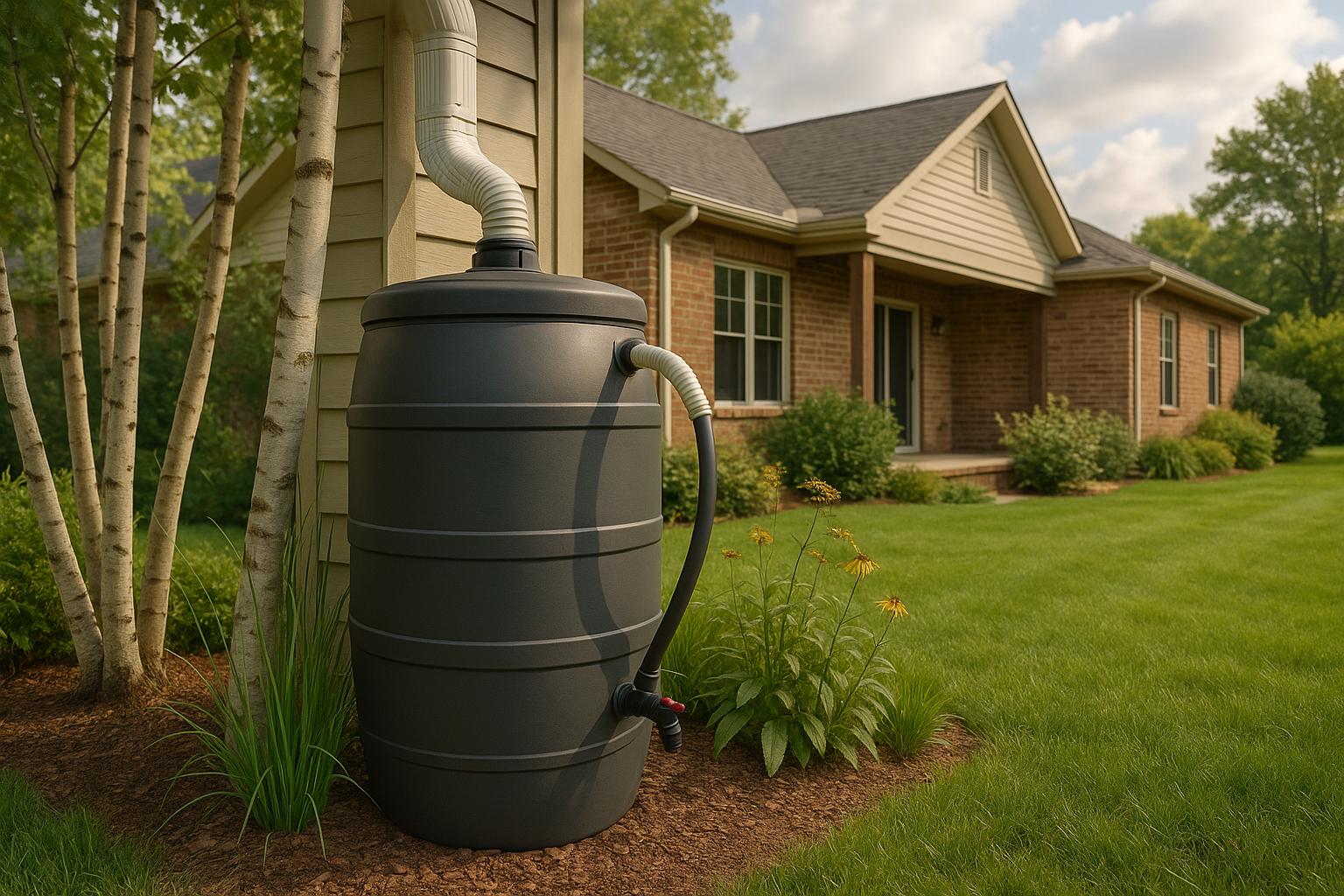- bhavya gada
- No Comments
Rainwater harvesting is a simple way to collect and store rainwater for outdoor tasks like watering gardens or managing stormwater. Here’s what you need to know:
- How It Works: Collect rainwater from your roof, filter out debris, store it in barrels or tanks, and use it as needed.
- Why It Matters in Maryland:
- Reduces stormwater runoff, preventing flooding and erosion.
- Saves money by lowering water bills.
- Supports native plants with chemical-free water.
- Key Components:
- Collection: Gutters and downspouts channel rainwater.
- Storage: Use rain barrels for small needs or cisterns for larger demands.
- Filtration: Keeps water clean for longer use.
- Overflow Management: Redirects excess water safely.
Before installing, check local Maryland regulations and decide whether to DIY or hire a professional. Proper setup ensures efficient water use and protects your property.
How to Install a Rainwater Harvesting System – DIY
System Parts and Setup
Rainwater harvesting systems work by combining four key elements: collection, filtration, storage, and overflow management.
Water Collection Methods
Rainwater is collected through a roof and gutter system, which channels the water toward storage. It’s important to ensure gutters are properly angled to maintain consistent flow and prevent water from pooling.
Storage Options: Barrels and Cisterns
Storage comes in two main forms – rain barrels and cisterns. Rain barrels are great for smaller needs, like watering a garden. For larger water demands, cisterns are a better fit. They can be installed above or below ground, depending on your space and requirements. Think about how much water you use and the space you have before deciding on the right storage option.
Filters and Overflow Management
Filtration and overflow control are essential for keeping the system working well and maintaining water quality. Advanced filters help keep stored water cleaner for longer. Overflow systems are equally important – they redirect excess water to safe areas, like rain gardens or drainage systems, protecting your property from flooding during heavy rains.
These elements form the foundation for designing an efficient rainwater harvesting system.
Planning Your Maryland System
Planning Checklist
Before setting up your system, take these factors into account:
Roof Assessment
- Measure your roof area in square feet.
- Ensure your roof material is suitable for collecting water.
- Inspect gutters for condition and capacity.
Storage Requirements
- Check available storage space and its proximity to utilities.
- Evaluate soil stability around the intended storage area.
System Integration
- Consider existing landscape features.
- Review current drainage patterns.
- Identify connection points for gardens or irrigation systems.
Maryland Rules and Permits
Before installing a rainwater harvesting system in Maryland, check local regulations. While most residential setups don’t need major permits, it’s essential to:
- Contact your county’s building department.
- Review any applicable homeowners association (HOA) rules.
- Confirm adherence to Maryland stormwater management regulations.
- Ensure overflow management complies with local codes.
These steps can help determine whether you should tackle the project yourself or hire a professional.
Self-Install or Hire Help
Choose your installation method based on the project’s complexity and your skill level.
DIY Installation
Best for straightforward setups that require minimal adjustments and basic plumbing skills:
- Small systems with 1–2 rain barrels.
- Limited changes to your landscape.
- Basic plumbing tasks.
Professional Installation
Consider hiring experts for more intricate systems, such as:
- Complex drainage installations.
- Integrated landscape designs.
- Underground cisterns.
- Systems with multiple collection points.
"Pro Landscapes MD specializes in creating outdoor environments that blend beauty, function, and sustainability" [1].
Professionals bring valuable expertise, including:
- Soil condition assessments.
- Use of high-quality equipment and materials.
- Seamless integration with existing drainage and landscaping.
- Assurance of regulatory compliance.
- Ongoing maintenance support.
A proper installation ensures your system runs efficiently and lasts longer. Choose the option that aligns with your system’s complexity and the landscape conditions in your area.
sbb-itb-843f8be
Advantages for Maryland Homes
Rainwater harvesting offers Maryland homeowners practical benefits like reducing runoff, saving on water costs, and improving garden growth.
Less Water Runoff
Maryland’s clay-heavy soils and older drainage systems often struggle during heavy rain. Collecting rainwater helps prevent soil erosion, basement flooding, and strain on local drainage systems. Besides protecting your home, it can also have a noticeable effect on your water usage.
Lower Water Bills
Using collected rainwater for tasks like watering plants, washing cars, or outdoor cleaning means less reliance on municipal water. This not only lowers your utility bills but also provides a cost-effective way to maintain your outdoor spaces.
Healthier Gardens
Rainwater is free from chemicals like chlorine that are commonly found in municipal water. This makes it better for your garden, creating ideal conditions for plants to thrive – whether you’re growing flowers, vegetables, or shrubs. It’s a simple way to keep your plants happy and healthy.
Next Steps
With the basics in place, take a moment to go over the key details before proceeding.
Key Points to Remember
A rainwater harvesting system needs three essential components to work effectively: proper collection, sufficient storage, and reliable filtration. When done right, these systems help cut down on municipal water usage and naturally irrigate your garden or landscape.
Services from Pro Landscapes MD

Pro Landscapes MD specializes in professional installation that seamlessly integrates your rainwater harvesting system with your existing landscape and drainage setup. Their services include:
- Custom system designs tailored to your property
- Professional installation of collection systems
- Integration with your current drainage system
- Landscaping solutions designed with sustainability in mind
Their team can help you decide between a DIY approach and professional installation, ensuring compliance with local codes and extending the life of your system. Pro Landscapes MD also offers expert consultations to assess your property’s specific needs. Call them at (940) 9664 to schedule a consultation and get a free project proposal for your rainwater harvesting system.
With the right design, skilled installation, and consistent maintenance, you can get the most out of your rainwater harvesting system.
FAQs
What permits and regulations should Maryland homeowners know about before installing a rainwater harvesting system?
Rainwater harvesting systems in Maryland may require compliance with local building codes, zoning laws, and environmental regulations. Specific requirements can vary by county, so it’s essential to check with your local government offices or the Maryland Department of the Environment (MDE) for guidance.
You might need permits for system installation, especially if it involves connecting to existing plumbing or altering stormwater drainage. Additionally, some areas may have restrictions on the use of harvested rainwater, such as for potable purposes. Consulting with a professional installer or landscaper familiar with Maryland’s regulations, like Pro Landscapes MD, can help ensure your system meets all legal and environmental standards.
How can I choose the right size and type of rainwater storage, like barrels or cisterns, for my home in Maryland?
To determine the right size and type of rainwater storage for your needs, consider factors such as your roof size, average rainfall in Maryland, and how you plan to use the collected water. For smaller-scale uses like watering plants or washing outdoor surfaces, rain barrels (typically 50–100 gallons) are a simple and cost-effective option. For larger-scale needs, such as irrigation or household use, cisterns (ranging from hundreds to thousands of gallons) may be more suitable.
Keep in mind that Maryland experiences moderate rainfall, so calculating your roof’s water collection potential can help you estimate storage requirements. For example, 1 inch of rain on a 1,000-square-foot roof can yield about 620 gallons of water. Additionally, ensure your storage system complies with local regulations and is designed to prevent contamination or overflow. If you’re unsure, consulting a professional service like Pro Landscapes MD can help you create a system tailored to your property and water usage goals.
Why should I hire a professional to install a rainwater harvesting system instead of doing it myself?
Hiring a professional to install a rainwater harvesting system ensures the job is done correctly, efficiently, and in compliance with local regulations. Professionals have the expertise to design a system tailored to your property’s unique needs, ensuring optimal water collection and storage capacity. They can also address potential challenges like proper drainage, overflow management, and filtration.
Attempting a DIY installation can be time-consuming and may lead to costly mistakes if the system isn’t installed properly. A professional ensures the system operates efficiently, saving you time, effort, and potentially reducing long-term maintenance costs. For Maryland homeowners, working with a trusted local expert can also help you navigate any state-specific guidelines or incentives for rainwater harvesting.


















Chat with Us